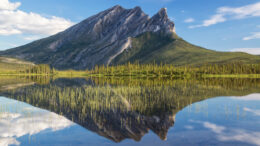Life in these modern times: masks indoors for Covid, masks outside for wildfire smoke. Welcome to Links From the Brink.
Best News (and Worst) of the Month: The media is finally paying attention to climate change and, for the most part, covering it accurately.
This is an important shift, as journalism’s longstanding policy of presenting both sides of a story allowed too many climate deniers and industry hacks to get their disinformation out there and, in the process, confused the public about the nature and threats of global warming. This false balance undoubtedly served to delay concrete action for decades.
But the scientific evidence of climate change is now incontrovertible, while deniers’ arguments are anything but, and the media has taken notice. A new study examined more than 2,600 news articles published between 2005 and 2019 and found that 90% of them “accurately represented climate change,” and that this accuracy improved over time.
You can see this shift still taking place today, with outlets like The New York Times publishing articles asking “What role does climate change play in disasters like the Tennessee flooding?”
Of course, there’s an exception to this trend. Conservative media, the study found, publishes fewer articles about climate change, and only 71% of those articles reflected the scientific consensus.

We found this dichotomy in action on Aug. 9 following the release of the latest report from the Intergovernmental Panel on Climate Change. The major media I checked that day — including the Times, The Washington Post, CNN and the Associated Press — all carried this bleak news as their lead story. That wasn’t the case for right-wing news sites like Fox News and Newsmax, which both covered the IPCC report, but only by republishing a short AP article and posting it way, way, way below the top of the page. Readers could only find it if they scrolled past headlines designed to drum up fears about Antifa, immigrants at the border, the “left-wing media,” the Green New Deal, sports’ stars “anti-American” attitudes, vaccination mandates and violent crime.
That’s by design, not by indifference. Fox News and other broadcast outlets still gave airtime to “discredited contrarians and climate deniers to discuss, or tried to downplay the stark findings,” according to Media Matters for America, a nonprofit that monitors conservative misinformation, which also found that these right-wing outlets aired far fewer segments about the new IPCC report than they have in the past.
That lack of coverage itself is disinformation. By being quiet or devoting their scaled-back efforts to discrediting the IPCC report, they told readers and viewers that climate change is nothing to worry about or a left-wing hoax.
So, all things considered, we’ve made progress. But right-wing disinformation still plays a major in American public life, and that’s going to keep causing trouble — and delaying both understanding of climate change and action against it — for years to come.
Buzzworthy Science: A team of scientists this month provided a list of “eight simple actions that individuals can take to save insects” amidst the ongoing declines. Some of the recommendations are for individual action, like replacing lawns with native plants, but several aim to improve the conservation outlook for insects overall. They’re all backed up with the latest evidence and clear examples of how these actions have helped in cases around the world.
A Wild Fantasy: One of our favorite articles of the month came from The Guardian, which profiled Irish baron and death-metal enthusiast Randal Plunkett’s efforts to rewild his 1,600-acre ancestral estate, which his family has owned since 1402. Locals called him an “idiot” for getting rid of the estate’s traditional lawns, cattle and sheep, but now the property has grown so wild and hosts so much biodiversity that biologists frequently journey there to study its success. The official Dunsany Nature Reserve account on Instagram showcases the many species that live on the estate, including deer, foxes, hedgehogs, birds, butterflies and a wide variety of plants.
View this post on Instagram
What the article doesn’t mention is how Plunkett’s ancestry fits into all of this. You see, he’s the 21st Baron of Dunsany. The 18th baron, Edward John Moreton Drax Plunkett (1878-1957), wrote hundreds of books, stories and plays under the name “Lord Dunsany,” through which he arguably created modern-day fantasy and horror fiction, much of which resonates with his descendant’s work today. “The need for human reunification with the natural world was the overriding theme that permeated all his works,” according to the website Irish Identity.
Here’s one of my favorite Lord Dunsany lines: “Ivy dreams sullenly and alone of overthrowing the cities.” Now his modern-day lineage has made that quote come alive.
More Rewilding: Irish aristocrats don’t have a monopoly on rewilding. Here are some related stories from the past few weeks:
-
- What is rewilding and can it restore our ecosystems?
- Ground broken for ‘world’s first rewilding centre’ near Loch Ness
- Going wild: How Scots are working to save nature through rewilding
- Why is rewilding Argentina ‘essential for our survival’?
- Eager beavers make a comeback! Rewilding success may see them return across Britain
- Farmers in England begin massive DIY rewilding effort
- The British teens inspiring us to get into rewilding — and how you can get involved too
- Rewilding is a two-way street
- Rewilding death: The plan to restore the necrobiome
- Critically endangered brush-tailed bettongs reintroduced in Australian rewilding project
- Rewilding 5% of England could create 20,000 rural jobs
Santa’s Gonna Be Pissed: Wildfire smoke reached the North Pole for the first time this month, thanks to the record-setting fires in Siberia. Meanwhile, new research finds the Russian Arctic is losing billions of tons of ice a year due to climate change, and so much ice is melting in Greenland (and down south in Antarctica) that the freakin’ Earth’s crust is starting to warp.
Speaking of Greenland, did you hear that it rained at the Greenland ice sheet’s highest point this month — for the first time in recorded history? And yes, that’s just going to make the ice there melt even faster.
As if the specter of resulting sea-level rise weren’t bad enough, all this melting creates other threats to people and wildlife, including landslides and the release of toxic pollution.
And this is only going to accelerate, as the Arctic’s oldest ice is now being pushed by excessive wind patterns into warming waters, where it too is melting. Eventually, scientists warn, the loss of sunlight-reflecting ice will cause more of the sun’s heat to be absorbed by the ocean, further speeding up the effects of global warming.
So yeah, Santa’s probably not in the best mood this year. Plan those holiday wish lists carefully.
Speaking of which, what do we put in naughty kids’ stockings now that coal needs to stay in the ground? Because I can think of a few fossil-fuel executives who don’t deserve any treats this (or any) year.
A Life in Beauty: Whenever we need to illustrate an article about the value of public lands, we’ve always turned to one man: Bob Wick. As a photographer for the Bureau of Land Management, Wick’s images have done more than just capture the beauty of wild spaces in the United States, they flat out inspired us.
Wick retired this month, but his photos will live on, as you can see in the video below.
What’s Next? August ended with some small but significant progress on the Democrats’ big infrastructure bill, which includes numerous climate-related provisions, and we expect that to dominate the discussion throughout September.
Our eyes will also be on California, were the upcoming gubernatorial recall election could have negative environmental consequences not just for the state but the whole world.
September will also bring World Cleanup Day on the 18th, World Gorilla Day on the 24th and World Environmental Health Day on the 26th.
(Wait, shouldn’t every day be environmental health day?)
What are you watching or waiting for in the months ahead? Good news or bad, drop us a line anytime.
That does it for this edition of Links From the Brink. For more environmental news throughout the month, including bigger stories you won’t find anywhere else, subscribe to the Revelator newsletter or follow us on Facebook or Twitter.
![]()


